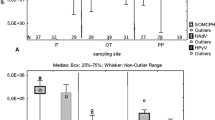Abstract
It is generally accepted that viral particles in source water are likely to be found as aggregates attached to other particles. For this reason, it is important to investigate the disinfection efficacy of chlorine on aggregated viruses. A method to produce adenovirus particle aggregation was developed for this study. Negative stain electron microscopy was used to measure aggregation before and after addition of virus particles to surface water at different pH and specific conductance levels. The impact of aggregation on the efficacy of chlorine disinfection was also examined. Disinfection experiments with human adenovirus 2 (HAdV2) in source water were conducted using 0.2 mg/L free chlorine at 5 °C. Aggregation of HAdV2 in source water (≥3 aggregated particles) remained higher at higher specific conductance and pH levels. However, aggregation was highly variable, with the percentage of particles present in aggregates ranging from 43 to 71 %. Upon addition into source water, the aggregation percentage dropped dramatically. On average, chlorination CT values (chlorine concentration in mg/L × time in min) for 3-log10 inactivation of aggregated HAdV2 were up to three times higher than those for dispersed HAdV2, indicating that aggregation reduced the disinfection rate. This information can be used by water utilities and regulators to guide decision making regarding disinfection of viruses in water.





Similar content being viewed by others
References
Albinana-Gimenez, N., Miagostovich, M. P., Calgua, B., Huguet, J. M., Matia, L., & Girones, R. (2009). Analysis of adenoviruses and polyomaviruses quantified by qPCR as indicators of water quality in source and drinking water treatment plants. Water Research, 43, 2011–2019.
APHA. (2005). Standard methods for the examination of water and wastewater (21st ed.). Washington, DC: American Public Health Association.
Cromeans, T. L., Kahler, A. M., & Hill, V. R. (2010). Inactivation of adenoviruses, enteroviruses, and murine norovirus in water by free chlorine and monochloramine. Applied and Environmental Microbiology, 76(4), 1028–1033.
Cromeans, T. L., Lu, X., Erdman, D. D., Humphrey, C. D., & Hill, V. R. (2008). Development of plaque assays for adenoviruses 40 and 41. Journal of Virological Methods, 151(1), 140–145.
Floyd, R., & Sharp, D. G. (1977). Aggregation of poliovirus and reovirus by dilution in water. Applied and Environment Microbiology, 33(1), 159–167.
Floyd, R., & Sharp, D. G. (1978). Viral aggregation: effects of salts on the aggregation of poliovirus and reovirus at low pH. Applied and Environment Microbiology, 35(6), 1084–1094.
Floyd, R., & Sharp, D. G. (1979). Viral aggregation: buffer effects in the aggregation of poliovirus and reovirus at low and high pH. Applied and Environmental Microbiology, 38(3), 395–401.
Galdiero, F. (1979). Adenovirus aggregation and preservation in extracellular environment. Archives of Virology, 59, 99–105.
Gutierrez, L., Mylon, S. E., Nash, B., & Nguyen, T. H. (2010). Deposition and aggregation kinetics of rotavirus in divalent cation solutions. Environmental Science and Technology, 44, 4552–4557.
Haas, C. N., & Joffe, J. (1994). Disinfection under dynamic conditions - modification of Hom model for decay. [Article]. Environmental Science and Technology, 28(7), 1367–1369
Kahler, A. M., Cromeans, T. L., Roberts, J. M., & Hill, V. R. (2010). Effects of source water quality on chlorine inactivation of adenovirus, coxsackievirus, echovirus, and murine norovirus. Applied and Environmental Microbiology, 76(15), 5159–5164.
Langlet, J., Gaboriaud, F., Duval, J. F. L., & Gantzer, C. (2008). Aggregation and surface properties of F-specific RNA phages: implication for membrane filtration processes. Water Research, 42, 2769–2777.
Mattle, M. J., & Kohn, T. (2012). Inactivation and tailing during UV254 disinfection of viruses: Contributions of viral aggregation, light shielding within viral aggregates, and recombination. Environmental Science and Technology, 46(18), 10022–10030. doi:10.1021/es302058v.
Monroe, J. H., & Brandt, P. M. (1970). Rapid semiquantitative method for screening large numbers of virus samples by negative stain electron microscopy. Applied Microbiology, 20, 259–262.
Moshe, A., & Gorovits, R. (2012). Virus-induced aggregates in infected cells. [Review]. Viruses-Basel, 4(10), 2218–2232, doi:10.3390/v4102218.
Sharp, D. G. (1949). Enumeration of virus particles by electron micrography. Proceedings Society Experimental Biology Medicine, 70, 54–59.
Sharp, D. G. (1965). Quantitative use of the electron microscope in virus research. Laboratory Investigation, 14, 93–125.
Sobsey, M. D., Fuji, T., & Hall, R. M. (1991). Inactivation of cell-associated and dispersed hepatitis A virus in water. Journal of the American Water Works Association, 83(11), 64–67.
Templeton, M. R., Andrews, R. C., & Hofmann, R. (2008). Particle-associated viruses in water: impacts on disinfection processes. Critical Reviews in Environmental Science and Technology, 38, 137–164.
Thurston-Enriquez, J. A., Haas, C. N., Jacangelo, J., & Gerba, C. P. (2003). Chlorine inactivation of adenovirus type 40 and feline calicivirus. Applied and Environmental Microbiology, 69(7), 3979–3985.
USEPA. (1991). Guidance Manual for Compliance With the Filtration and Disinfection Requirements for Public Water Systems Using Surface Water Sources. Washington, DC: USEPA Office of Drinking Water.
Van Heerden, J., Ehlers, M. M., Van Zyl, W. B., & Grabow, W. O. (2003). Incidence of adenoviruses in raw and treated water. Water Research, 37(15), 3704–3708.
Wong, K., Mukherjee, B., Kahler, A. M., Zepp, R., & Molina, M. (2012). Influence of inorganic ions on aggregation and adsorption behaviors of human andenovirus. Environmental Science and Technology, 46, 11145–11153.
Acknowledgments
The authors thank Bonnie Mull (CDC) for assistance with disinfection experiments, and Washington Aqueduct staff for providing source water. Funding for this project was provided in part by the Water Research Foundation (Project #3134, Contaminant Candidate List Viruses: Evaluation of Disinfection Efficacy). The use of trade names and names of commercial sources is for identification only and does not imply endorsement by the Centers for Disease Control and Prevention or the U.S. Department of Health and Human Services. The findings and conclusions in this presentation are those of the authors and do not necessarily represent those of the Centers for Disease Control and Prevention.
Author information
Authors and Affiliations
Corresponding author
Rights and permissions
About this article
Cite this article
Kahler, A.M., Cromeans, T.L., Metcalfe, M.G. et al. Aggregation of Adenovirus 2 in Source Water and Impacts on Disinfection by Chlorine. Food Environ Virol 8, 148–155 (2016). https://doi.org/10.1007/s12560-016-9232-x
Received:
Accepted:
Published:
Issue Date:
DOI: https://doi.org/10.1007/s12560-016-9232-x




